步态分析与训练
步态分析及其矫治训练

五、臀大肌(髋伸肌)步态
• 臀大肌无力者,而关节后伸无力,足跟着地时常 用力将胸部后仰,使重力线落在髋关节后方,以 维持够关节被动伸展,站立中期时膝关节绷直, 形成仰胸挺腰腹的臀大肌步态。
六、股四头肌步态
股四头肌麻痹者,行 走中患侧腿站立相伸 膝的稳定性将受到影 响,表现为足跟着地 后,臀大肌为代偿股 四头肌的功能而使髋 关节伸展,膝关节被 动伸直,造成膝反张 。如同时有伸髋肌无 力,则患者俯身用手 按压大腿,使膝伸直 。
肌肉的代偿。胫前肌肉物理可以引起足背屈力量弱,足 接触地面时拍地,而非足跟开始向前滚动。 4.肌肉张力改变:绝大部分上运动神经元损伤可引起肌肉 张力的改变,其中最常见的是速度依赖的牵张反射亢进 5.此外,关节僵硬可以影响身体各节段间的相对快速移动 ,限制身体的前行
步态异常的原因
肌肉调控异常 主动肌和拮抗肌同时沙后所可以增加僵硬的 程度,减少活动性。 小脑损伤病人可出现肌肉调控异常,导致共 济失调。
二、适应症
1.中枢神经系统损伤 如脑卒中、脑外伤后偏瘫 、脑瘫、帕金森病、小脑及其传导路病变 2.骨关节疾病与外伤 截肢、髋膝关节置换术后 、关节炎、韧损伤、踝扭伤、下肢不等长等 3.下肢肌力损伤 脊髓灰质炎、股神经损伤、腓 神经损伤等 4.其他 疼痛、孕妇步行等
二、禁忌症
严重心肺疾患、下肢骨折未愈合、检查不配合 者不宜进行步态分析
•
(髋关节最大屈曲)
骨盘: 5°旋 髋关节:2 0°~ 30°屈曲 膝关节::60°~ 30°屈曲 踝关节:1 0°跖屈~ 0°
迈步相末期(85~100%)
从地面垂直的小腿向前摆动到该侧足跟再 次着地之前。此时小腿减速向前摆动。
骨盘: 5°旋前 髋关节:3 0°屈曲 膝关节: 30°屈曲~ 0° 踝关节:0°
步态检测评估与训练系统技术要求
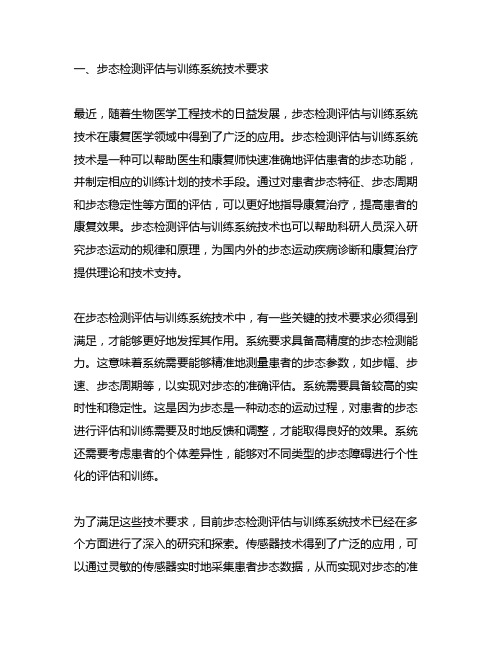
一、步态检测评估与训练系统技术要求最近,随着生物医学工程技术的日益发展,步态检测评估与训练系统技术在康复医学领域中得到了广泛的应用。
步态检测评估与训练系统技术是一种可以帮助医生和康复师快速准确地评估患者的步态功能,并制定相应的训练计划的技术手段。
通过对患者步态特征、步态周期和步态稳定性等方面的评估,可以更好地指导康复治疗,提高患者的康复效果。
步态检测评估与训练系统技术也可以帮助科研人员深入研究步态运动的规律和原理,为国内外的步态运动疾病诊断和康复治疗提供理论和技术支持。
在步态检测评估与训练系统技术中,有一些关键的技术要求必须得到满足,才能够更好地发挥其作用。
系统要求具备高精度的步态检测能力。
这意味着系统需要能够精准地测量患者的步态参数,如步幅、步速、步态周期等,以实现对步态的准确评估。
系统需要具备较高的实时性和稳定性。
这是因为步态是一种动态的运动过程,对患者的步态进行评估和训练需要及时地反馈和调整,才能取得良好的效果。
系统还需要考虑患者的个体差异性,能够对不同类型的步态障碍进行个性化的评估和训练。
为了满足这些技术要求,目前步态检测评估与训练系统技术已经在多个方面进行了深入的研究和探索。
传感器技术得到了广泛的应用,可以通过灵敏的传感器实时地采集患者步态数据,从而实现对步态的准确评估。
机器学习和人工智能技术的引入,也为步态检测评估与训练系统技术的发展带来了新的机遇。
通过对大量步态数据的学习和分析,可以实现对步态特征的自动识别和评估,提高了步态检测的精度和效率。
虚拟现实技术和增强现实技术的应用,也为步态训练和康复提供了新的手段和途径。
患者可以在虚拟环境中进行步态训练,提高训练的趣味性和有效性。
步态检测评估与训练系统技术的发展,为步态检测评估与训练系统技术要求的实现提供了更加全面和优质的解决方案。
二、对步态检测评估与训练系统技术的理解和观点步态检测评估与训练系统技术无疑是康复医学领域的一个重要的技术创新和突破。
步态分析与步行训练
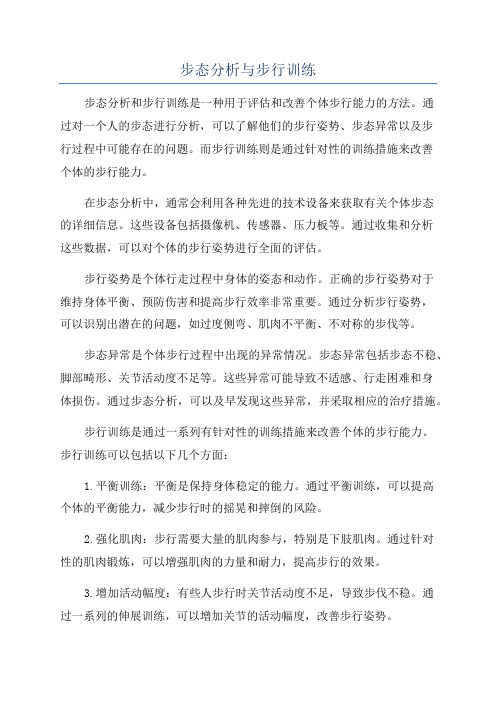
步态分析与步行训练步态分析和步行训练是一种用于评估和改善个体步行能力的方法。
通过对一个人的步态进行分析,可以了解他们的步行姿势、步态异常以及步行过程中可能存在的问题。
而步行训练则是通过针对性的训练措施来改善个体的步行能力。
在步态分析中,通常会利用各种先进的技术设备来获取有关个体步态的详细信息。
这些设备包括摄像机、传感器、压力板等。
通过收集和分析这些数据,可以对个体的步行姿势进行全面的评估。
步行姿势是个体行走过程中身体的姿态和动作。
正确的步行姿势对于维持身体平衡、预防伤害和提高步行效率非常重要。
通过分析步行姿势,可以识别出潜在的问题,如过度侧弯、肌肉不平衡、不对称的步伐等。
步态异常是个体步行过程中出现的异常情况。
步态异常包括步态不稳、脚部畸形、关节活动度不足等。
这些异常可能导致不适感、行走困难和身体损伤。
通过步态分析,可以及早发现这些异常,并采取相应的治疗措施。
步行训练是通过一系列有针对性的训练措施来改善个体的步行能力。
步行训练可以包括以下几个方面:1.平衡训练:平衡是保持身体稳定的能力。
通过平衡训练,可以提高个体的平衡能力,减少步行时的摇晃和摔倒的风险。
2.强化肌肉:步行需要大量的肌肉参与,特别是下肢肌肉。
通过针对性的肌肉锻炼,可以增强肌肉的力量和耐力,提高步行的效果。
3.增加活动幅度:有些人步行时关节活动度不足,导致步伐不稳。
通过一系列的伸展训练,可以增加关节的活动幅度,改善步行姿势。
4.步行器具使用:对于一些行走困难的人群,如老年人、残疾人等,可以使用步行辅助器具来帮助他们行走。
通过正确使用步行辅助器具,可以提高步行的稳定性和安全性。
步态分析和步行训练在康复医学和运动医学领域非常重要。
它们不仅可以帮助康复患者恢复步行能力,还可以帮助运动员优化步行技术,提高竞技能力。
在日常生活中,正确的步行姿势和步行能力对于身体健康非常重要,因此步态分析和步行训练也可以用于普通人的健康管理。
人体步态分析实验报告(3篇)
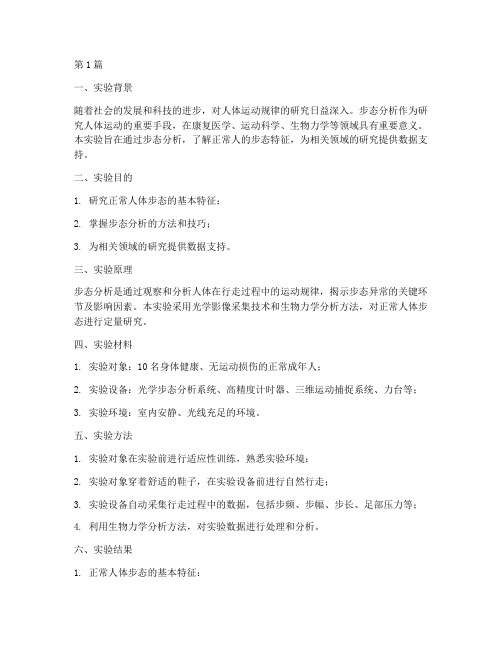
第1篇一、实验背景随着社会的发展和科技的进步,对人体运动规律的研究日益深入。
步态分析作为研究人体运动的重要手段,在康复医学、运动科学、生物力学等领域具有重要意义。
本实验旨在通过步态分析,了解正常人的步态特征,为相关领域的研究提供数据支持。
二、实验目的1. 研究正常人体步态的基本特征;2. 掌握步态分析的方法和技巧;3. 为相关领域的研究提供数据支持。
三、实验原理步态分析是通过观察和分析人体在行走过程中的运动规律,揭示步态异常的关键环节及影响因素。
本实验采用光学影像采集技术和生物力学分析方法,对正常人体步态进行定量研究。
四、实验材料1. 实验对象:10名身体健康、无运动损伤的正常成年人;2. 实验设备:光学步态分析系统、高精度计时器、三维运动捕捉系统、力台等;3. 实验环境:室内安静、光线充足的环境。
五、实验方法1. 实验对象在实验前进行适应性训练,熟悉实验环境;2. 实验对象穿着舒适的鞋子,在实验设备前进行自然行走;3. 实验设备自动采集行走过程中的数据,包括步频、步幅、步长、足部压力等;4. 利用生物力学分析方法,对实验数据进行处理和分析。
六、实验结果1. 正常人体步态的基本特征:- 步频:每分钟80-120步;- 步幅:0.5-0.8米;- 步长:0.7-1.0米;- 足部压力:足跟先着地,足中部着地,足尖离地;- 躯干姿态:保持直立,头部与脊柱呈一直线;- 下肢运动:髋关节、膝关节、踝关节协调运动,保持稳定。
2. 实验数据分析:- 步频、步幅、步长等参数在正常范围内;- 足部压力分布均匀;- 躯干姿态稳定;- 下肢运动协调。
七、实验结论1. 正常人体步态具有规律性和稳定性;2. 步态分析是研究人体运动的重要手段,可以为相关领域的研究提供数据支持;3. 本实验为步态分析提供了可靠的数据,有助于进一步研究步态异常的原因和治疗方法。
八、实验讨论1. 步态分析在康复医学中的应用:- 评估患者的步态异常情况;- 制定个性化的康复方案;- 评估康复治疗效果。
常见异常步态的分析与训练

(二)参与的主要肌肉活动
3.髂腰肌(iliopsoas) 为髋关节屈肌,髋关节于足跟离地至足趾 离地期间伸展角度达到峰值(10°~15°)。为对抗髋关节伸展, 从支持相中期开始至足趾离地前,髂腰肌呈离心性收缩,最终使髋关 节从支撑相末期由伸展转为屈曲。髂腰肌第二次收缩活动始于摆动相 初期,使髋关节屈曲,以保证下肢向前摆动。
3. 股四头肌步态 股神经损伤时,屈髋关节伸膝关节受限。行走时,由 于股四头肌无力,不能维持膝关节的稳定性,支撑相膝后伸,躯干 前倾,重力线落在膝前。整个行走过程重心在垂直位移动的幅度较 大。
上肢与下肢 上肢摆动方向与下肢相反,才可以达到维持 身体平衡,减少转动。
肩关节 自由摆动约30 °(屈曲约6°,后伸约24°)。
(二)参与的主要肌肉活动
步行的动力主要来源于下肢及躯干的肌肉作用,在一个步行 周期中,肌肉活动具有保持平衡、吸收震荡、加速、减速和 推动肢体运动的功能。
1.竖脊肌(erector spinae) 为背部深层肌,纵列于脊柱 两侧,下起骶骨、髂骨,上止椎骨、肋骨、枕骨,作用为使 脊柱后伸、头后仰和维持人体于直立姿势。在步行周期站立 相初期和末期,竖脊肌活动达到高峰,以确保行走时躯干正 直。
2. 臀中肌步态 臀上神经损伤或髋关节骨性关节炎时,髋关节外展、 内旋外旋均受限,行走时由于臀中肌无力,使骨盆控制能力下降, 支撑相受累侧的躯干和骨盆过度倾斜,摆动相膝关节和踝关节屈曲 增加以保证地面廓清,身体向两侧摇摆,典型步态特征呈鸭步。整 个行走过程重心在水平面左右方向的移位要大于在垂直面内的移位。
势,包括单腿站立时,躯干保持稳定不许动; 5. 侧方迈步(横行)步行训练,开始横行训练时,
可让患者背靠墙走,以增加安全性,随患者能力 的提高,可上跑步机上训练横行,并可逐步增加 坡度和速度。
脑卒中偏瘫步态分析与训练ppt课件
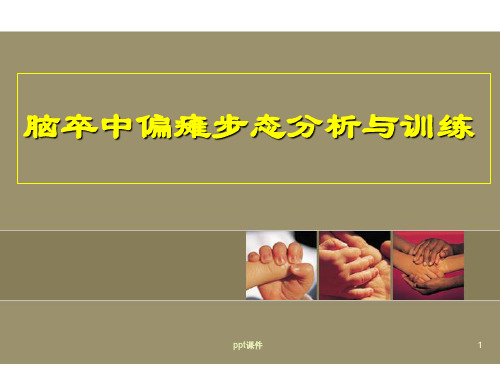
脑卒中偏瘫步态分析
踝关节训练器的训练形式 被动运动(Passive ) 主动运动( Active )
ppt课件
26
脑卒中偏瘫步态分析
被动运动(Passive )
整圈旋转(起始位置:水平、垂直、放射状态) 设定:治疗时间(1~99min);顺或逆时针方向(1~200圈反向交替);速度
(50%~100%,即:15~30转/分) 部分旋转(起始位置:水平、垂直、放射状态) 设定:治疗时间(1~99min);部分旋转(10°~500°)起点在设定范围中间
正常步态应是平稳、协调、有节律的,两腿交替进行。
ppt课件
4
脑卒中偏瘫步态
参与行走任何环节的失调都可能影响步态,而某些异常也有可 能被代偿或掩盖。
ppt课件
5
脑卒中偏瘫步态分析
行走 会走:能单腿负重、
立位平衡2级、 出现分离运动 走好:进行步态分析
行 走
产生
步 态
进行
步 态 分
析
ppt课件
ppt课件
18
脑卒中偏瘫步态分析
肌力训练方法
肌力小于等于3级时,运用各种治疗技术诱发和强化肌肉力量 肌力超过3级时,运用等速肌力训练
ppt课件
19
脑卒中偏瘫步态分析
核心肌群训练
训练背阔肌、竖脊肌向心和离心等速肌力训练
ppt课件
20
脑卒中偏瘫步态分析
核心肌群训练 训练腹直肌和竖脊肌向心等速肌力训练
6
脑卒中偏瘫步态分析
站立初期(足跟/足着地和负重) 踝关节背屈受限 ——胫前肌群活动降低 ——腓肠肌挛缩和/或僵硬 膝关节屈曲不能(膝过伸) ——比目鱼肌挛缩 ——股四头肌0º~15º控制受限
步态训练的训练方法

步态训练的训练方法
步态训练是一种重要的康复训练方法,主要针对步态异常、步态失调的患者,通过有计划、有针对性的训练,帮助患者恢复正常步态,提高日常生活能力。
以下是步态训练的训练方法:
1. 步态分析:首先需要对患者的步态进行全面细致的分析,包括站立、行走等环节,确定步态异常的具体表现和原因。
2. 目标制定:根据步态分析结果,制定可行的训练目标,包括改善步态异常、提高步态稳定性、增强肌肉力量等。
3. 动作练习:根据训练目标,制定相应的动作练习方案,例如平衡练习、步幅练习、腿部肌肉力量训练等,通过反复练习不断提高患者的步态能力。
4. 器械辅助:在步态训练中,可以适当使用一些器械辅助,如平衡板、步态分析仪等,帮助患者更好地进行动作练习,加速步态训练的进程。
5. 长期跟踪:步态训练是一个长期的过程,需要根据患者的实际情况进行跟踪评估,及时调整训练方案,确保步态训练效果最大化。
总之,步态训练是一项复杂而重要的康复训练方法,需要医护人员制定科学的训练方案,并与患者密切合作,共同完成步态训练的过程。
- 1 -。
步态训练的训练方法

步态训练的训练方法步态训练是一种常见的康复训练方法,适用于多种疾病和损伤的患者。
步态训练的目的是帮助患者恢复或改善步态,提高行走能力和生活质量。
本文将介绍步态训练的训练方法,包括评估、目标制定、训练计划、训练方法和效果评估。
一、评估评估是步态训练的第一步,它可以帮助理解患者的病情、能力和需求,为训练制定合适的目标和计划。
评估包括以下几个方面:1. 步态分析步态分析是评估步态的基础,它可以帮助发现步态异常和问题。
步态分析包括观察、测量和分析步态的各个方面,如步长、步速、步态稳定性、支撑相和摆动相等。
2. 肌力和关节活动度评估肌力和关节活动度评估可以帮助了解患者的肌力和关节活动度状况,为训练制定合适的强化和伸展计划。
3. 平衡评估平衡评估可以帮助了解患者的平衡能力状况,为训练制定合适的平衡训练计划。
二、目标制定目标是步态训练的核心,它可以帮助患者明确自己的训练目的和期望效果。
目标应该具体、可行和有挑战性,以激励患者积极参与训练。
常见的步态训练目标包括:1. 提高步态稳定性步态稳定性是步态训练的重点之一,它可以帮助患者减少跌倒和受伤的风险。
提高步态稳定性的训练方法包括平衡训练、肌力强化和步态模拟训练等。
2. 增加步长和步速增加步长和步速可以帮助患者提高行走能力和生活质量。
增加步长和步速的训练方法包括步态模拟训练、步态节奏训练和肌力强化等。
3. 改善步态对称性步态对称性是步态训练的重要目标之一,它可以帮助患者改善步态异常和问题。
改善步态对称性的训练方法包括肌力平衡训练、关节伸展和步态模拟训练等。
三、训练计划训练计划是步态训练的框架,它可以帮助患者规划训练内容、频率和时长。
训练计划应该根据患者的评估结果和目标制定,具体可分为以下几个方面:1. 训练内容训练内容应该根据患者的评估结果和目标制定,包括平衡训练、肌力强化、关节伸展和步态模拟训练等。
2. 训练频率训练频率应该根据患者的能力和需求制定,一般建议每周训练3-5次,每次训练30-60分钟。
步态分析实训结论总结报告

一、引言步态分析作为运动医学、康复医学和生物力学等领域的重要研究手段,对于评估人体运动功能、诊断疾病以及制定康复训练计划具有重要意义。
本次实训旨在通过步态分析实验,了解步态分析的基本原理、方法和应用,并总结实训过程中的经验和结论。
二、实训目的1. 掌握步态分析的基本原理和方法。
2. 学会使用步态分析设备进行数据采集和分析。
3. 提高对步态异常的识别和评估能力。
4. 了解步态分析在临床应用中的价值。
三、实训内容与方法1. 步态分析原理介绍:讲解了步态分析的基本概念、步态周期的划分以及影响步态的因素。
2. 步态分析设备操作:介绍了步态分析设备的使用方法,包括测力台、压力垫、三维运动捕捉系统等。
3. 实验操作:在实验室内进行步态分析实验,包括受试者选择、数据采集、数据分析等环节。
4. 结果分析:对实验数据进行统计分析,包括步频、步幅、步态周期、关节角度等指标。
四、实训结论1. 步态分析是一种有效评估人体运动功能的方法,可以帮助我们了解受试者的步态特征和运动能力。
2. 步态分析设备具有高度的准确性和可靠性,能够为临床诊断和治疗提供科学依据。
3. 步态分析在康复医学中具有重要意义,可以帮助康复治疗师制定个性化的康复训练计划。
4. 步态分析在运动医学领域也有广泛应用,可以帮助运动员提高运动表现,预防运动损伤。
5. 步态分析在临床应用中具有以下优势:(1)客观性:步态分析数据客观、准确,不受主观因素的影响。
(2)全面性:步态分析可以全面评估受试者的步态特征,包括步频、步幅、步态周期、关节角度等指标。
(3)动态性:步态分析可以动态观察受试者的步态变化,为临床诊断和治疗提供实时反馈。
五、实训经验与体会1. 步态分析实验过程中,要注意受试者的安全,确保实验顺利进行。
2. 在数据采集过程中,要严格按照操作规程进行,保证数据的准确性和可靠性。
3. 数据分析时要充分了解受试者的运动背景和病史,结合临床经验进行综合评估。
4. 步态分析结果要与临床诊断相结合,为临床治疗提供有力支持。
脑卒中偏瘫步行训练精品PPT课件

结果:患侧支撑不稳,站立 相缩短;对侧腿提前触地; 行走速度减慢
20
偏瘫步态分析
偏瘫腿摆动期:
---最常见髋关节屈曲角度不足、膝关节屈伸速度减缓和屈髋不足为特征的下 肢僵硬摆动。
点;步宽越窄,步行的稳定性越差;
13
14
偏瘫患者步态
偏瘫患者步行周期特点
--患侧上肢摆动时协同屈曲、内收;患侧下肢伸肌协同运动。 • 步速慢,患侧支撑时间缩短,健侧步幅缩短 • 患侧踝关节跖屈,足尖着地,膝反张;摆动相患侧肩关节下降、
骨盆抬高,下肢向外划圈,“划圈步态”。
15
偏瘫步态分析
支撑初期: 表现:“足外侧着地”或“前足
• 髂腰肌肌力降低可能是原发因素
• 改善髂腰肌肌力是关键。
22
偏瘫步态训练
(一)步行基础训练
1.体位适应性训练
2.肌力训练
桥式运动和垫上训练
上肢主要肌群力量的训练:肩带肌、肘伸肌、腕伸肌的肌力训练
下肢主要肌群力量的训练:伸髋肌、髂腰肌、髋外展肌、膝关节伸展、 屈曲肌群的肌力训练
3.关节活动度训练
(二)平衡训练
踝跖屈肌挛缩或痉挛,支撑相胫骨不能前移导致膝关节过 伸; 股四头肌无力导致过伸才能负重; 股四头肌痉挛导致膝关节突然伸展
膝过伸的训练:
--矫正足下垂 --站立位膝关节在5—10°范围内控制性屈曲和伸展:先双侧下 肢,然后患 侧下肢。
---“划圈步态”:髋关节屈曲角度不充分,加上膝关节屈曲和踝背屈不能,
导致僵硬的下肢出现向前的患者外旋和外展髋部使腿向外侧摆动,然后内 收和内旋使腿向内侧摆回。
偏瘫步态分析及训练

镇静;无力(巴氯芬;替扎尼定) 妙纳基本无副作用
神经溶解技术
注射部位:胫神经和胫神经运动分支 注射药物:50%—100%酒精3-7ml 定位技术:低频电刺激 特点:优点是廉价、在短期内可以重复
使用;缺点是可以引起感觉障碍
肉毒毒素局部注射
注射肌肉:小腿后群肌 注射方法:腓肠肌、比目鱼肌从小腿后
步长(step length):一侧足根着地至对 侧足跟着地时两点间的距离。
步基宽(stride width):每侧足根着地其 中点连接成线,左右两侧连线之间的距 离。正常约为5~10cm。
步态的基本测量
步行速度( m/s,m/min):单位时间内行走 的距离,正常人平均自然步速约为 1.2m/s。
屈
训练目的 摆动相 站立相 站立相 站立相
作业导向步行训练方法
方法 向一侧迈步 向一侧上台阶 在足印迹上步行 在平行线内步行
训练目的 侧方运动 侧方运动 增加步长 减少步宽
运动想象疗法
运动想象疗法是指为了提高运动功能而 进行的反复运动想象,没有任何运动输 出,根据运动记忆在大脑中激活某一活 动的特定区域
偏瘫患者的支撑相和摆动相的关节运动 学与正常人有区别,而且个体差异很大
支撑相运动学异常:髋关节
支撑相时髋伸展很重要,它可以使躯干 在支撑相下肢上方前移
偏瘫患者常常存在髋伸展下降 —踝跖屈肌过度活跃 —髋伸展力矩下降 —髋屈肌过度活跃
支撑相运动学异常:膝关节
支撑相时膝屈曲增加(特别是在足首次 着地时)
面进针;胫后肌、趾长屈肌、拇长屈肌 从侧方或后方进针
踝足矫形器(AFO)
分类:主要分三大类 塑料AFO 金属AFO:优点是质地硬,带关节 前置踝足矫形器
步态训练的训练方法

步态训练的训练方法步态训练是通过特定的训练方法,对人体步态进行调整和改善,以提高行走能力、减轻疲劳、预防和治疗各种疾病。
步态训练是一项复杂的任务,需要综合考虑多个因素,如姿态、动作、力量、协调等方面。
在本文中,我们将介绍步态训练的训练方法,以帮助读者更好地理解和应用步态训练。
一、步态分析步态分析是步态训练的前提和基础,通过对步态的分析和评估,可以了解个体存在的问题和需要改善的方面。
步态分析包括静态分析和动态分析两部分,静态分析主要是对姿态和关节角度的检查,动态分析则是对步态的整体运动过程进行观察和分析。
在步态分析中,应该特别注意以下几个方面:1.姿态:包括头部、脊柱、骨盆、肩膀等部位的位置和姿态,应该保持合适的位置和角度。
2.步幅:步幅指的是每一步的距离,应该根据个体的身体状况和步态特点进行调整。
3.步频:步频指的是每分钟走的步数,应该根据个体的身体状况和步态特点进行调整。
4.支撑相和摆动相:支撑相指的是脚着地到脚离地的这段时间,摆动相指的是脚离地到脚着地的这段时间,两个相位的时长应该合适。
5.步态节律:步态节律指的是每一步的节奏和规律,应该根据个体的身体状况和步态特点进行调整。
二、步态训练方法1.平衡训练平衡训练是步态训练的基础,通过平衡训练可以提高个体的平衡能力和协调能力,从而减少跌倒的风险。
平衡训练包括以下几个方面:(1)单脚站立:单脚站立是平衡训练的基础,可以提高个体的平衡和协调能力。
(2)单脚跳跃:单脚跳跃可以提高个体的爆发力和协调能力,也可以促进肌肉的发展。
(3)单脚踢球:单脚踢球可以提高个体的平衡和协调能力,也可以锻炼腿部肌肉。
(4)平衡板训练:平衡板训练可以提高个体的平衡和协调能力,也可以锻炼腿部肌肉。
2.步态训练步态训练是通过特定的训练方法,对个体的步态进行调整和改善,以提高行走能力、减轻疲劳、预防和治疗各种疾病。
步态训练包括以下几个方面:(1)步幅训练:步幅训练可以提高个体的步幅和步速,也可以促进肌肉的发展。
康复步态训练方法

康复步态训练方法
康复步态训练方法是一种针对运动障碍患者的物理治疗方法,旨在帮助患者恢复正常步态、提高步行能力和平衡能力。
以下是一些常见的康复步态训练方法:
1. 拐杖辅助训练:对于一些行动不便的患者,使用拐杖可以帮助他们保持平衡并减轻身体负担。
在进行步态训练时,拐杖可以作为辅助工具,帮助患者稳定身体并提供支撑。
2. 步态分析:步态分析是一种通过观察患者行走过程中的各个关节动作来判断步态是否正常的方法。
医生可以根据分析结果对患者的训练方案进行优化。
3. 坡度训练:通过训练患者在不同坡度的地面上行走,可以提高其步行能力和平衡能力。
坡度训练还可以帮助患者逐渐适应不同的地形环境,提高生活自理能力。
4. 平衡训练:针对一些步态不稳定的患者,医生可以采用平衡练习来帮助其恢复平衡能力。
常见的平衡练习包括单脚站立、前后倾身体平衡、双脚交替跳跃等。
5. 步态重建:一些严重运动障碍的患者可能需要进行步态重建训练。
这种训练方法包括利用功能电刺激仪等技术,通过刺激肌肉来重建患者的运动能力。
康复步态训练方法需要根据患者的具体情况进行选择和调整,训练期间需要医生的指导和监督。
通过持续的康复训练,患者可以逐渐恢复正常的步态和运动能力,提高生活质量。
偏瘫步态分析与训练

偏瘫步态分析与训练偏瘫是指中枢神经系统受损导致肢体功能障碍,多见于中风患者。
偏瘫患者的步态异常是其主要症状之一,因此偏瘫步态分析与训练对于康复非常重要。
本文将重点讨论偏瘫步态分析与训练的内容,以及如何有效地进行康复训练。
1.瘫痪侧肢体的肌力减弱或完全丧失:偏瘫患者的瘫痪侧肢体往往无法主动运动或运动能力受限,因此步态分析中需要考虑到肌力的问题,从而确定训练的目标和内容。
2.瘫痪侧肢体的肌张力异常:偏瘫患者的瘫痪侧肢体往往会出现肌张力增高(痉挛)或减低(松弛)的情况,这会直接影响步态的表现。
因此,在步态分析中需要留意肌张力的异常,并相应地调整训练计划。
3.瘫痪侧肢体的关节活动度减少:由于肌力减弱和肌张力异常,偏瘫患者的瘫痪侧肢体关节的活动度会受到限制,表现为关节屈曲或伸直受限等。
因此,在步态分析中需要关注关节活动度的变化,并在训练中采取相应的措施来改善关节活动度。
基于以上分析,进行偏瘫步态的康复训练是非常重要的。
以下是一些常用的康复训练方法:1.肌力训练:通过理法、疏松拉伸等手段,针对性地增强瘫痪侧肢体的肌力。
常用的方法包括日常功能训练、肌力锻炼等。
2.关节活动度训练:通过主被动活动和适当的牵引手法,增加瘫痪侧肢体关节的活动度。
可以进行主动活动训练、被动活动训练、关节牵引等。
3.平衡训练:通过单脚站立、平衡木步行等训练,提高偏瘫患者的平衡能力。
还可以使用平衡器械进行恢复训练。
4.步态训练:通过正常步态模式的重塑,改善偏瘫患者的步态异常。
根据具体情况,可以采用步态辅具,如助行器、拐杖等。
5.动作训练:通过各种复合动作训练,培养瘫痪侧肢体的协调性和灵活性。
常见的动作训练包括平坐到站立、跪到站立等。
在进行康复训练时,需要注意以下几点:1.康复训练应个体化:由于偏瘫步态的差异较大,每个患者的康复训练计划应该针对其具体情况进行制定,避免一刀切的模式。
2.康复训练应进行系统性:康复训练需要系统规划,从基础训练逐渐过渡到高级训练,以达到更好的康复效果。
常见异常步态的分析与训练

正常步态中关节和肌肉的活动
(一)身体主要部位及关节的活动 人在步行时为了减少能量的消耗,身体各部位要尽量维持正常活动范
围的运动,减少身体的重心移动。 1.骨盆 骨盆移动可以被认为是重心的移动。正常成人在步行时身体
重心的位置在骨盆的正中线上,从下方起男性约为身高的55%,女性 约为50%的高度。步行时重心的上下移动为正弦曲线,在一个步行周 期中出现两次,其振幅约4.5cm,最高点是支撑中期,最低点是足跟 着地;骨盆的侧方移动也是正弦曲线,在一个步行周期内左、右各出 现一次,其振幅约3cm,最大移动度是在左、右足处于支撑中期时出 现的,在双足支撑期重心位于左右中间。
上肢与下肢 上肢摆动方向与下肢相反,才可以达到维持 身体平衡,减少转动。
肩关节 自由摆动约30 °(屈曲约6°,后伸约24°)。
(二)参与的主要肌肉活动
步行的动力主要来源于下肢及躯干的肌肉作用,在一个步行 周期中,肌肉活动具有保持平衡、吸收震荡、加速、减速和 推动肢体运动的功能。
1.竖脊肌(erector spinae) 为背部深层肌,纵列于脊柱 两侧,下起骶骨、髂骨,上止椎骨、肋骨、枕骨,作用为使 脊柱后伸、头后仰和维持人体于直立姿势。在步行周期站立 相初期和末期,竖脊肌活动达到高峰,以确保行走时躯干正 直。
(二)参与的主要肌肉活动
5.缝匠肌(sartorius) 是全身最长的肌,起于髂前上棘, 经大腿的前面,斜向下内,止于胫骨上端的内侧面,作用为屈 髋和屈膝关节,并使已屈的膝关节旋内。在支撑相末期和摆动 相初期,作用为屈膝、屈髋,在摆动相末期和支撑相初期,使 膝关节旋内。
6.腘绳肌(hamstring) 包括股二头肌、半腱肌、半膜肌, 均起于坐骨结节,跨越髋、膝两个关节,分别止于腓骨头和胫 骨粗隆内下方、胫骨内侧髁,作用为伸髋屈膝。主要收缩活动 始于摆动相末期,足跟着地时达到活动高峰并持续到支撑相。 在摆动相末期,作为屈膝肌,腘绳肌离心性收缩使小腿向前的 摆动减速,以配合臀大肌收缩活动(使大腿向前摆动减速), 为足跟着地做准备。足跟着地时及着地后,腘绳肌又作为伸髋 肌,协助臀大肌伸髋,同时通过稳定骨盆,防止躯干前倾。
偏瘫步态分析与训练ppt课件
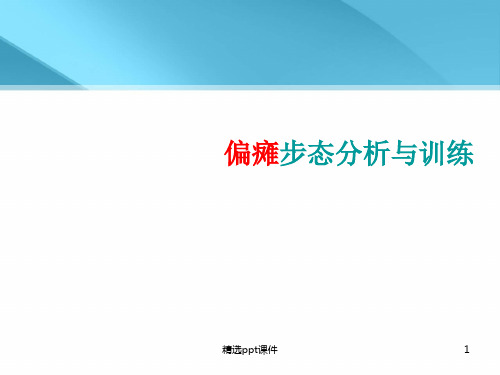
精选ppt课件
23
迈步相初期( 60~70%GC)
• 从支撑腿 离地到该 腿膝关节 达到最大 屈曲时。
精选ppt课件
24
迈步相中期( 70~85%GC )
• 指下肢向前摆 动的动作过程 中,从膝关节 最大屈曲摆动 到小腿与地面 垂直的时期。
精选ppt课件
26
迈步相末期( 85~100%GC )
精选ppt课件
28
偏瘫患者的双腿支撑相 偏瘫患者双腿支撑相与正常人 的相比,绝对时间都延长 , 所占百分比都增大,原因是双 腿支撑相时间延长可增加步态 稳定性。
精选ppt课件
29
偏瘫患者的迈步相
偏瘫患者的健侧与患侧的迈步相明显不
同,患侧迈步相的时间比健侧时间长, 百分比比健侧大,Brandstater报道, 患侧迈步相的时间平均为0.53~ 1.03 s,健侧为0.32~0.56 s, 且患侧迈步相的时间比正常人的时间长,
精选ppt课件
34
步宽(stride width)
• 指左、右两足间的横向距离,通常 以足跟中点为测量点,正常大约510cm。步宽愈窄,步行的稳定性愈 差。
精选ppt课件
35
步角(foot angle)
• 在行走中前进的方向与足的长轴所形成的夹角称为足 角,如下图示,通常用°表示,健全人约为6.75°。
精选ppt课件
13
迈步相(swing phase)
步行周期中从足趾离地到同侧足 跟再次着地的过程。约占40%GC。一 侧下肢迈步相时间等于对侧下肢单 支撑期时间。
精选ppt课件
14
步行周期
精选ppt课件
15
站立相分期
• 首次着地 • 足放平(负荷反应期,预负荷) • 站立中期 • 足跟离地(站立相末期) • 足趾离地(迈步相前期)
步态分析完整版

步态分析完整版步态分析是研究人类行走过程中身体各部位运动规律和协调性的科学方法。
它通过观察和分析人的行走姿态,评估人的运动功能,帮助医生、康复师和运动教练制定个性化的治疗方案和训练计划。
本完整版文档将详细介绍步态分析的基本概念、方法、应用以及最新研究成果。
一、基本概念1. 步态周期:行走过程中,从一侧脚跟触地到下一次该脚跟触地的整个过程,称为一个步态周期。
一个完整的步态周期可以分为两个阶段:支撑相和摆动相。
2. 支撑相:指脚与地面接触的时间段,占整个步态周期的60%左右。
在这个阶段,身体的重心从一侧脚转移到另一侧脚。
3. 摆动相:指脚离开地面向前摆动的阶段,占整个步态周期的40%左右。
在这个阶段,身体的重心向前移动。
4. 步态参数:包括步长、步频、步宽、步速等。
这些参数可以反映一个人的行走能力和运动状态。
二、步态分析方法1. 观察法:通过肉眼观察行走过程中的姿态和动作,评估步态的异常情况。
这种方法简单易行,但主观性强,误差较大。
2. 动态足迹分析:通过测量行走过程中脚与地面接触的痕迹,分析步态的稳定性和协调性。
这种方法可以提供较为客观的数据,但无法观察整个行走过程。
3. 三维运动捕捉技术:利用多个摄像头捕捉行走过程中身体各部位的运动轨迹,三维模型,进行详细分析。
这种方法可以提供最全面、最精确的数据,但成本较高,技术要求较高。
4. 动力分析:通过测量行走过程中地面反作用力和关节力矩,分析步态的动力学特征。
这种方法可以深入了解行走过程中的能量消耗和肌肉活动,但需要专业的设备和技术支持。
三、步态分析应用步态分析在临床医学、康复医学、运动训练等领域具有广泛的应用价值。
例如:1. 诊断神经系统疾病:通过步态分析,可以早期发现帕金森病、脊髓损伤等神经系统疾病,为治疗提供依据。
2. 评估康复效果:在康复训练过程中,通过步态分析,可以实时监测患者的行走能力变化,评估康复效果,调整训练方案。
3. 优化运动训练:对于运动员和健身爱好者,步态分析可以帮助发现行走过程中的不足,制定针对性的训练计划,提高运动表现。
- 1、下载文档前请自行甄别文档内容的完整性,平台不提供额外的编辑、内容补充、找答案等附加服务。
- 2、"仅部分预览"的文档,不可在线预览部分如存在完整性等问题,可反馈申请退款(可完整预览的文档不适用该条件!)。
- 3、如文档侵犯您的权益,请联系客服反馈,我们会尽快为您处理(人工客服工作时间:9:00-18:30)。
摆动初期 (Initial swing)
60-73% of gait cycle From toe off to feet adjacent 脚离开地面(Foot clearance of the floor) 肢体从后摆向前(Advancement of the limb
from its trailing position)
自然步态的生物力学因素
具备控制肢体前向运动的肌力或机械能。 可以在足触地时有效地吸收机械能,以减小撞
击,并控制身体的前向进程。 支撑相有合理的肌力及髋膝踝角度(重力方向),
以及充分的支撑面(足的位置)。 摆动相有足够的推进力、充分的下肢地面廓清
和合理的足触地姿势控制。
6
自然步态的要点
(1) 合理的步长、步宽、步频。 (2) 上身姿势稳定。 (3) 最佳能量消耗。
7
临床步态分析
临床步态分析旨在
通过生物力学和运动学手段,揭示步态异常 的关键环节和影响因素。
协助康复评估和治疗。 协助临床诊断、疗效评估、机理研究等。
8
步态分析(gait analysis)
时间-距离参数
包括步长、步幅、步宽、步向角、步速、步频、步行周
期、支撑相时间、摆动相时间等。
运动学参数
动能和势能 Kinetic and potential energy considerations
动能:步行速度是人体步行时动能的直接反应
势能:是人体质量因重力作用而表现的能量。
步态周期动能/势能关系
动能 最小 最大
重心位置 最高 最低
势能 最大 最小
运动学分析
Walking can be defined as a series of losses and recoveries of balance 步行是一个连续地失去平衡和恢复平衡的过程
重心移动(躯体运动) Displacement of the Center of Mass
Total vertical displacement: 5 cm 垂直移动
步态周期 (Gait Cycle)
双腿支撑相 (Double support phase)10%x2
支撑期 (Stance phase) 60%
摆动期(Swing phase) 40%
步态周期分期-1
Stance phase:足跟着地、足掌着地、 支撑中期、足跟离地 、足尖离地
Swing phase:摆动早期、中期、晚期
支撑末期 (Terminal stance)
30-50% of gait cycle From heel rise to opposite initial contact 身体行进越过支撑脚(Progression of the
body beyond the supporting foot)
跨步时间:行走时,一侧脚跟着地到该侧脚跟再次着地 ,这一过程所占用的时间,也就是步态周期 stride time is the time for a full gait cycle
单跨步时间:行走时,一侧脚跟着地到紧接着对侧脚跟 着地,这一过程所占用的时间 step time is the time for the completion of a right or a left step.
Temporal Descriptors of Gait 时间参数
Cadence 步调 Stride time 跨步时间 Step time 单跨步时间
Spatial/Temporal Descriptor空间/时间参数
Walking speed 步速
空间参数 Spatial Descriptors of Gait
空间参数 Spatial Descriptors of Gait
跨步长 Stride length
Foot angle
Step length 步长
步宽 Step width
时间参数
Temporal Descriptors of Gait
步调(步频):指单位时间内行走的步数 cadence is the number of steps per minute, which is also called step rate.
87-100% of gait cycle From tibia vertical to initial contact for the
next stride 肢体向前摆动完成 准备肢体站立(Prepare limb for stance)
身体重心的移动和控制
The body‘s CoM is located just anterior to the second sacral vertebra 人体重心位于人体第二骶椎椎体的前缘
垂直运动是指从双腿站立相(步态周期的最低点) 到单腿站立相中期(步态周期的最高点)身体重 心的垂直运动距离。
躯体的侧方运动 Total medial-lateral displacement
侧方移位是每一次跨步时,身体重心从一侧到另一侧 总的移动距离,指从一侧单腿站立相中期到另一侧 单腿站立相中期重心的侧方运动
vertical displacement
重心移动(躯体运动) Displacement of the Center of Mass
Total medial-lateral displacement: 4 cm
侧方移动
medial-lateral displacement
躯体的垂直运动 Total vertical displacement
500.00ms e c .
时间和空间测量
TEMPORAL AND SPATIAL ESCRIPTORS
Spatial Descriptors of Gait 空间参数
Stride length 步幅 Step length 步长 Step width 步宽 Foot angle 足偏角
空间/时间参数 Spatial/Temporal Descriptor
步速:单位时间内步行的距离 Walking speed combines both spatial and temporal measurements by providing information on the distance covered in a given amount of time.
摆动中期 (Mid-swing)
73-87 % of gait cycle From feet adjacent to tibia vertical 肢体向前摆动(Limb advancement) 脚离开地面(Foot clearance from the floor)
摆动末期 (Terminal swing)
步幅(跨步长):行走时,由一侧脚跟着地到该侧脚跟再 次着地所进行的距离 Stride length is the distance between two successive heel contacts of the same foot.
步长:行走时,一侧脚跟着地到紧接着对侧脚跟着地所 进行的距离称为步长,也称单步长 Step length is the distance between successive heel contacts of the two different feet.
Normal Values for Gait
Gait speed: 1.37 m/s (3 km/h) Step rate: 1.87 steps/s (110 steps/m) Step length: 72 cm (28 inches)
步态周期 (Gait Cycle)
人在行走时,从一侧足跟着地起到该侧足跟再次着地 为止所用的过程被称为一个步行周期。
The gait cycle is initiated as soon as the foot contacts the ground. Because foot contact is normally made with the heel, the 0% point or beginning of the gait cycle is referred to as heel contact, or heel strike, The 100% point or cornpletion of the gait cycle occurs as soon as the same foot once again makes contact with the ground.
摆动前期 (Pre-swing)
50-60% of gait cycle From opposite initial contact to toe off 双腿支撑期(Double support period) 体重过渡和重力转移(Weight release &
weight transfer) 确定肢体摆动的位置
是指步行中髋、膝、踝等关节的运动规律(角度、位移、
速度、加速度等),骨盆倾斜和旋转、身体重心位置的变
化规律等。
动力学参数
指引起运动的力学参数,包括地板反力、功与功率等。
肌电活动参数
8500.00ms e c .
1 .0 0
指步行过程中下肢主要肌肉的电生理活动指标。
能量代谢参数
指人体运动过程中的能量代谢情况。
支撑中期 (Mid-stance)
10-30% of gait cycle From opposite toe off to heel rise 行进到站立脚(Progression over the stationary
foot) 肢体和躯干稳定(Limb and trunk stability)
空间参数 Spatial Descriptors of Gait
